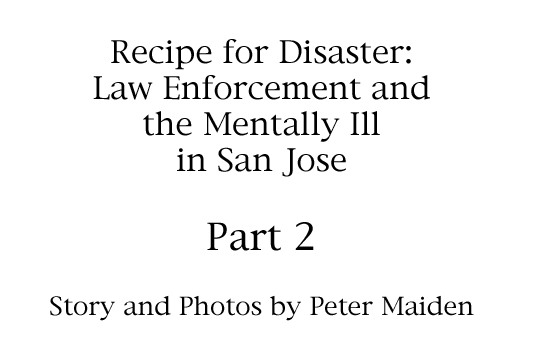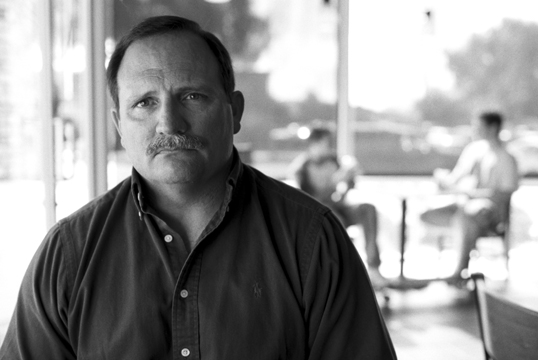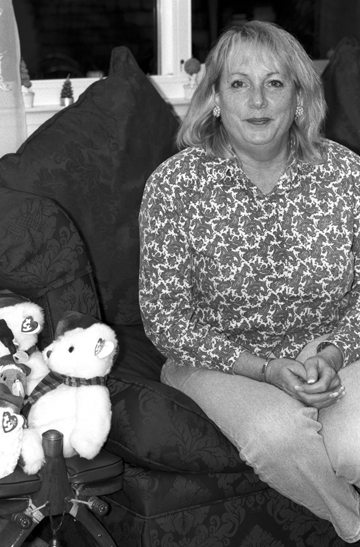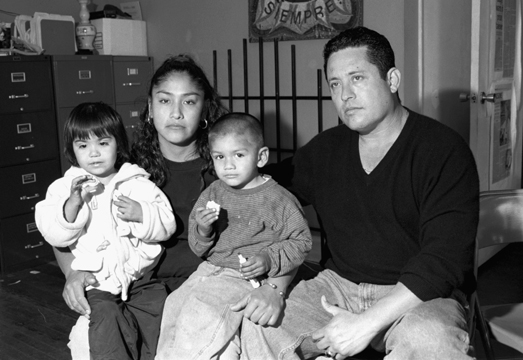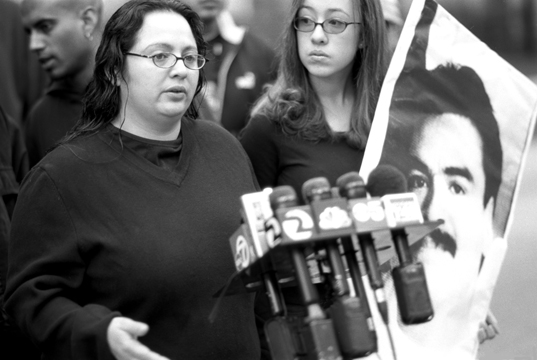From the Open-Publishing Calendar
From the Open-Publishing Newswire
Indybay Feature
This is part two of a two-part story. To read part one, <A href="/news/2005/06/1747132.php ">click here
THE CRISIS INTERVENTION TEAM
What is the SJPD doing about the way it deals with the mentally ill? There is an educational program that trains officers to become part of the Crisis Intervention Team (CIT). The CIT was initiated in San Jose in 1999, after first being pioneered in Memphis, where there had also been deaths of mentally ill people at the hands of the police. CIT training is a 40-hour program in the police academy. Officers are educated in the major mental illnesses, and they study psychopharmacology. They have lunch with clients and their families, and they visit mental hospitals and day treatment programs. Along with members of the staff of a suicide hotline, they do role-playing. Back in the field, CIT-trained officers are called into situations where the mentally ill are involved.
Officer Greg Sancier, a cop who holds a doctorate in Psychology, is currently in charge of the CIT training for the SJPD. The Department uses psychologists for giving officers therapy, screening applicants, and writing up profiles of criminal suspects. Officer Sancier, on the other hand, is in charge of how the Department deals with the mentally ill people officers come into contact with on the streets. I spoke with him at a Starbucks in San Jose’s Willow Glen neighborhood, and found him to have genuine, deep concern for the mentally ill, to the point where he could be the conscience of the Department regarding mental health issues.
“On the streets,” Officer Sancier said, “it’s not a clinical environment, so there can be a very chaotic, severe crisis that’s occurring in a person’s life which can affect the safety of themselves and the officer. There is an occasion when someone might be suicidal to the point where they have a weapon … and that’s when they would call in a CIT officer, because of certain communication skills and techniques and knowledge they have, based on the academy that they attended, to peacefully resolve that issue.” Officer Sancier is the senior hostage negotiator for the SJPD, and tries to impart the skills of a negotiator to the officers in the CIT training. “I have successfully defused quite a few incidents,” he said.
The CIT training is only available to 46 SJPD officers a year, and so far only 300 out of 1450 on the force have been trained. “Our goal is to train everyone,” Officer Sancier said. But at this rate it would take 25 years to train the entire Department. There is no funding to speed up the process.
Officer Sancier would not discuss specific cases, but he told me in general terms about police reaction to the death of a mentally ill person: “There is COMPLETE regret on behalf of the officers. Officers can live with that the rest of their lives, in terms of post-traumatic stress. It’s the most tragic of situations where someone with a mental illness is shot and killed. Despite the fact that the officer is still living, his life is never the same after that. A lot of officers go out on stress disabilities related to shootings. It’s a very tragic situation all the way around.”
I went on a ride-along with the SJPD—I was more or less embedded with a CIT-trained officer for a day. He was called to a situation at a high school, to interview a 15 year-old student who had reported a sexual assault. As the interview was sensitive, I was handed over to another officer. On the way out to that policeman’s car, I heard a Sheriff’s Deputy drawl, “At one time or another, we run into everyone in this County who’s on medication.” Two hours later we returned to the school, where the interview had been completed. Sitting in his patrol car, one officer said, “She’s on more medications than you can NAME. She recanted her story—the assault didn’t happen.” Then he looked far away, as if pondering something he just could not fathom.
Do police equate mental illness with criminality? In a phone call Officer Sancier was quick to point out that almost all crimes committed by the mentally ill are misdemeanors. He told me about a special court in San Jose where these offenses are handled in such a way as the suspects are directed towards therapy and rehabilitation instead of jail time. Yet the uncensored remarks I heard from officers on the job show a bias that could lead towards profiling of the mentally ill. That in turn could lead to police violence against them.
THE MAIN JAIL NIGHTMARE: A NURSE SPEAKS
What happens when the mentally ill enter the jail system? I interviewed two sources with experience inside the Jail, a former jail nurse and a former prisoner. They were candid in their descriptions of a corrupt system. They brought me to the realization that the Jail environment is even today a murky world of violent abuse. The nurse, Nancy Rutherford, could only stand working at the Main Jail for a couple of months. The prisoner, Martín Rodriguez, actually became psychotic because of conditions in the Main Jail.
According to a letter from the head of medical treatment in the Jail, in 2004 there were an average of 634 inmates who were being given psychiatric medication on any given day. A spokesperson for the Department of Corrections told me the entire population of the Main Jail in 2004 was around 1,400. This means that last year approximately 45% of the jail population was being medicated for mental illness. Ms. Rutherford, a veteran licensed vocational nurse, had the job of dispensing medication to these inmates. She spoke to me on two occasions in her San Jose home.
Ms. Rutherford said that psychiatric clients who are arrested face a terrible experience. “These people, imagine,” she said, “they come off the streets, maybe they drank on top of their other meds, and they don’t know which end is up. If the prisoners are mentally challenged, then they’re going to act out. Then if you’re kind of brutalized and shoved around or whatever, it’s a pretty bad experience. If these officers bring them in and, say, they’re feisty or something, I’m sure they’re rough with them.”
“The corrections officers are verbally abusive,” Ms. Rutherford continued, “and your rights are taken away. Some of the corrections officers can be very condescending, abusive, isolating these people, putting them in solitary confinement; some of it to me is going overboard. You might almost get them into a partial psychotic state, being alone and treated like this. You would treat an animal better. Some of the guards seem to have a vendetta, hurting people and being nasty. Some of them have that edge. You can see it. They don’t have a lot of compassion.”
“There were so many inmates that you couldn’t look at all of their diagnoses” she went on, “you’re just giving these drugs. My take on it is that they’re chemically controlling a lot of people. Years ago they had rehab; now they’re more controlled, I think, by the psychiatric drugs. [In addition] these drugs have a lot of side effects. They have to be monitored well and I question sometimes if they’re being monitored properly.”
Ms. Rutherford said she complained to a couple of the corrections officers at the jail about an inmate she treated whom she determined was hit by a guard while in handcuffs. The officers she spoke with reported her to her supervisor, asking that she no longer be allowed to dispense medication in their area. They claimed she was slow because she gave a measure of personal attention to the prisoners. The supervisor, Ms. Rutherford recalled, said to her: “We have to maintain a certain form of discipline here, you don’t want the prisoners to hear about dissention among the staff. You really have to watch what you say, because the news media may be around.” Coming up against what she saw as a wall of silence, Ms. Rutherford, disgusted, quit her job at the Jail. She now works in a locked psychiatric facility on the Peninsula.
THE MAIN JAIL NIGHTMARE: A PRISONER SPEAKS
A woman named Quetza, of an organization called the Barrio Defense Committee, asked that I interview a former inmate of the Main Jail who was beaten and tortured there, Martín Rodriguez. Mr. Rodriguez had gotten in touch with the Committee for help in defending against what he said were false charges, and getting recourse for his mistreatment at the Jail. I interviewed him in Spanish in the office of the Centro Aztlán in downtown San Jose, and then again by phone from his home on the East Side. “There are many forms of corruption in the jail system, affecting many people,” Mr. Rodriguez said. He told me the story of how he suffered a psychological breakdown in the Jail, where he was beaten and tortured on two occasions.
Mr. Rodriguez’ twelve year-old son had gotten involved in gang activities. On the night of July 10 of last year he heard there was going to be a gang fight where his son might be involved. He went to a house where he found a lot of kids, including his son. He was ready to take his son home when police drove up. The kids, most of them probably carrying drugs, scattered, leaving him and his son alone with the officers. Father and son were arrested, on charges Mr. Rodriguez says were all false. Among other things, he was charged with providing his son with methamphetamine. It was that accusation that led police in booking to become enraged while processing him. They beat him.
“I didn’t want to say anything!” he said, “I closed my eyes, and I told myself ‘It doesn’t hurt! It doesn’t hurt! It’ll end soon!” He was then chained to a chair, where a large officer tortured him by forcing his head down into his chest. “I couldn’t breathe,” he said, “I felt they were killing me, breaking me.”
Once in his cell, they gave Mr. Rodriguez painkillers for the injuries he sustained in booking. Then after a couple of weeks they took him off the pills and he had a bad reaction. He could no longer sleep or eat, and he began talking incessantly. He began to hallucinate. “I lost touch with reality,” he said. “I had read the bible a lot, and I thought I was David. I thought I was Cuautemoc, whose history I had read, and I thought I was Montezuma.”
Mr. Rodriguez was taken to the eighth floor of the jail, the location of the psychiatric unit. His family could no longer see him. He refused food and medication; he had come to believe he would be poisoned. On August 22, he was again beaten and tortured. He was pulled out of his padded cell by six guards. He resisted and they used painful compliance techniques to subdue him. He was hit on the head and body with batons. They tore off his clothes with such force he was afraid he would be raped. They took him to a wooden bed, where he was held down with straps on his wrists and ankles. At least one officer humiliated him by handling his penis. They had shields, which they pressed against his head, forcing it against the wooden bed, until he thought it would burst. He also felt that if he did not maintain pressure back against the pressure from the shields, his neck would snap. The abuse went on for fifteen or twenty minutes. There were a lot of people around. No one took his side. There was a female dressed in civilian clothes present and she laughed at his predicament. Others made jokes, including a gay male nurse.
“They break your body and your soul,” Mr. Rodriguez said. “They are very cruel there, they have no heart.” He said in conclusion, “Psychologically I will never be entirely well.”
Charges against Mr. Rodriguez for dealing methamphetamine and providing it to his son have been dropped because there was no evidence. However he still faces charges of possession and use of the drug. He tested positive for methamphetamine at the time of his arrest, a finding he contests. He has been working through channels to make his complaints and has filed a civil suit. He has had to reject several public defenders that wanted him to make a deal and plead guilty, one of which said that his refusal to plead guilty was a symptom of mental illness. He insists that he be allowed to prove his innocence.
CONCLUSION: HOW DEEP WILL CHANGE GO?
It is easy to despair of the situation between law enforcement and the mentally ill, and the glacial pace at which change would appear to be taking place. I was once told by a practicing psychiatrist that stigma against the mentally ill was a problem on the level of world hunger—huge, pervasive, and practically impossible to solve. Clearly change has to be deep. There are reforms in the works, but the situation calls for something revolutionary. Among citizens in San Jose, the mentally ill are probably the worst treated by law enforcement. If this mistreatment could be addressed and changed, it would stand to reason it would be to the benefit of all of the people of San Jose who come into contact with police or correctional officers.
There is a County organization, the Human Relations Commission, whose role it is to pursue issues of human rights. It tries to facilitate actions by people in the community for social change and has good connections with activists. This year the Commission will look into the treatment of the mentally ill by law enforcement. There is also a new Independent Police Auditor, named Barbara Attard. She is looking into 2004’s shootings by the SJPD, and although she was chosen for her position by the Chief of Police, there is hope she will be an agent for change. CIT training for the entire force would be a first step down the right road. A bright spot on the horizon is that money will be coming from new taxes mandated by Proposition 63, which taxes millionaires to fund programs that benefit the mentally ill.
Progress has occurred over the last thirty years in the handling of domestic abuse cases. In the old days a battering husband would be walked around the block to cool off, and then re-introduced into the home. Today he would be taken into custody and other steps taken to protect the battered wife. This is the level of change in police behavior that must, as a start, take place for the mentally ill. The police need to stop operating as if the streets of San Jose were in the Wild West. If they cannot control a situation, perhaps they need to leave it alone rather than turning it into a police shooting. Perhaps they need more often to risk an injury to themselves, to prevent the death of another.
The indictment of State Narcotics Agent Michael Walker last year for manslaughter in the shooting of Rudy Cardenas was a milestone. Mr. Cardenas was mistakenly thought to be a wanted parole violator because he fit the description of a Latino male with a moustache. Agent Walker shot him in the back while he was running away through a downtown San Jose alley. The prosecution of Agent Walker for manslaughter shows that people can be held accountable for murders committed behind the authority of a badge. That things have gone this far has a lot to do with the fact that the Cardenas family played a very strong role in pushing publicly for justice. They attended the open Grand Jury hearings that resulted in the indictment dressed in black. Agent Walker’s trial is set for September.
Civil litigation is an avenue of recourse. The family of Ms. Tran is suing the City of San Jose. On June 9, a jury awarded $1 million to the family of a man with schizophrenia, William Smith, who was killed by the SJPD on September 15, 2001. Mr. Smith was asphyxiated as eight officers subdued him after an episode in a MacDonald’s, where Mr. Smith was said to be yelling at customers. The officers were not disciplined. But the civil judgment brought a sense of closure to Mr. Smith’s family.
I joined San Jose’s Copwatch, which is coordinated by Quetza of the Barrio Defense Committee, as they policed the police one Friday night in April of this year. I saw how a new generation in San Jose is being criminalized. In the downtown area, scores of mostly Latino young people are pulled over by a large contingent of police. The police are intransigent and the youth become jaded and defiant. On the inside of the juvenile justice system, things are worse, and mental illness is a big problem. The Mercury News reported last October that 71% of the youths in juvenile detention in San Jose have “diagnosable mental disorders.” Will these kids grow up to lose their lives over a misdemeanor? Or commit suicide in a cell?
The community needs to be brought into policing in order to move beyond the dysfunctional relationship that is daily being played out between police and the mentally ill. As communities of workers and people of color could design means by which their oppression by police could be addressed, mental health clients and their families, who often know the most about how to help themselves, could have a say in how policing of the mentally ill is conducted. Community members themselves could handle a lot of this policing, perhaps working in a preventative mode. In addition, therapeutic programs could help clients understand that police are realistically very violent and should be treated with great caution.
The law enforcement establishment in San Jose needs to learn that mentally ill people, while they may be confused or upset at times, are usually non-confrontational and want a good outcome to a situation as much as anyone else. Being psychotic, while it requires treatment, should not be punishable by beating, torture, or death. Let’s live and let the mentally ill live. Let’s radically change the situation in San Jose so the mentally ill can survive to get healthier—so that perhaps they, too, can enjoy the pursuit of happiness. It’s in everyone’s interest.
We are 100% volunteer and depend on your participation to sustain our efforts!
Donate

$270.00 donated
in the past month
Get Involved
If you'd like to help with maintaining or developing the website, contact us.
